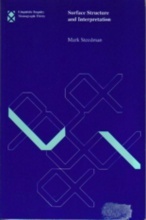Combinatory Categorial Grammar (CCG) offers a new approach to the theory of natural language grammar. Coordination, relativization, and related prosodic phenomena have been analyzed in CCG in terms of a radically revised notion of surface structure. CCG surface structures do not exhibit traditional notions of syntactic dominance and command, and do not constitute an autonomous level of representation. Instead, they reflect the computations by which a sentence may be realized or analyzed, to synchronously define a predicate-argument structure, or logical form. ‘Surface Structure and Interpretation’ shows that binding and control can be captured at this level, preserving the advantages of CCG as an account of coordination and unbounded dependency.pp. 126 #0120Z
SURFACE STRUCTURE AND INTERPRETATION
$10.00
Sold Out
Additional Information
| Author | Steedman, Mark |
|---|---|
| Number of pages | 126 |
| Publisher | MIT Press |
| Year Published | 1996 |
| Book Condition | FINE |
|---|---|
| Binding Type | Softcover |
